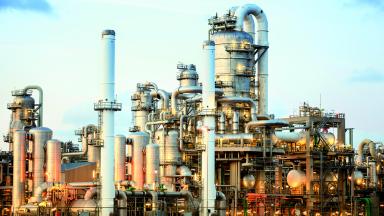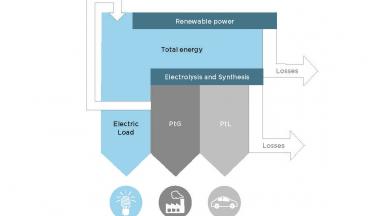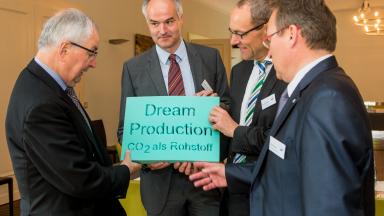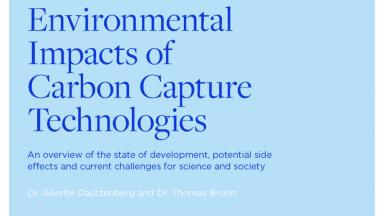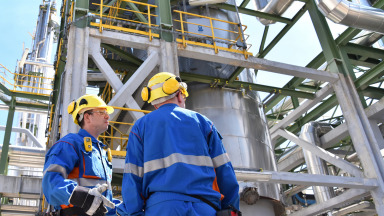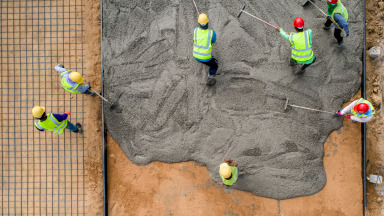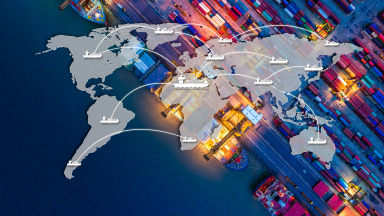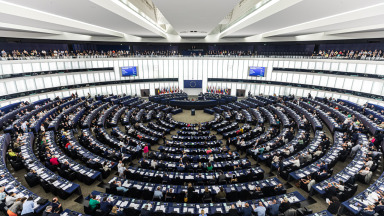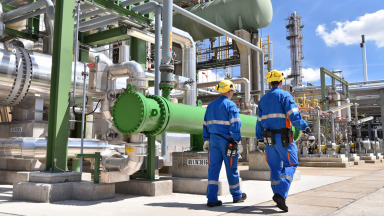CO₂: From Waste to Feedstock
25.08.2017
Economic activities and consumer behaviour in developed countries are currently based mainly on the use of fossil-based raw materials, and their emissions are largely responsible for anthropogenic climate change. In efforts to reduce human effects on the climate, the avoidance of carbon dioxide (CO2) emissions is and remains the most important measure. But high CO2 emissions go hand in hand with a demand for carbon in the form of many of the goods that we need on a daily basis, for example for the production of plastics or fuels. Can it therefore make sense to consider the greenhouse gas carbon dioxide (CO2) as a source of carbon? Since the 1970s, scientists have been researching carbon capture and utilization (CCU) technologies. The aim of these technologies is to re-cycle the CO2 contained in emissions as a feedstock for industrial processes. This captured CO2 could replace fossil-based carbon as a component of materials and energy carriers, thereby creating a carbon cycle.

Nature knows no waste. And even CO2 is not necessarily a waste product: photosynthesis continually transforms it in a natural cycle. But ever since the Industrial Revolution, humans have been throwing the carbon cycle off balance. Technologies aimed at recycling CO2 now present us with the possibility of imitating this natural cycle. For this to happen, the stable and low-energy CO2 molecule has to be incorporated into a higher-value product. This is made possible by developing new chemical processes, for example, in catalysis research. The challenge here lies in finding energy-efficient processes to do so.
That is why many countries have established research programmes to study the use of CO2. In the case of process emissions, which cannot be offset by the use of renewable energies, it is hoped that industry can be de-fossilised by implementing CCU. In Germany, the BMBF and the BMWi are currently funding numerous joint projects – and the intensive project funding is already showing signs of success: countless pilot and demonstration units exist, for example, polyols as a base material of foams are being produced in Dormagen and synthetic fuels are being manufactured in Werlte and Dresden. The first CO2-based products and fuels have already entered the markets. Possible sources for CO2 utilization are primarily industrial point sources. However, technologies for direct capture from the air have been developed considerably in recent years and are already in use. Possible finished products include plastics, building materials and liquid or gaseous fuels (see illustration).
Ecological and economic effects of using CO2
Unlike Carbon Capture and Storage (CCS) technologies, which aim to store large quantities of CO2 underground for a long period of time, in the case of CCU technologies, only a small amount of CO2 can be used in industrial processes. According to estimates, between 50 megatons (IEA 2019) and five gigatons of CO2 (Hepburn et al. 2019) could be used annually. The considerable difference between these two estimates is due to the consideration of various technologies as “CCU”. It is also important to bear in mind that the amount of used CO2 does not automatically correspond to the CO2 saved. What is more, the CO2 used in these products is only bound for the duration of their lifetimes. These varied greatly, for instance between fuels with a rapid re-release and building materials with long-term to permanent storage times. So, it is returned to the atmosphere with a delay or else captured once again from emissions after combustion processes. Thus, the ecological advantage of CO2 utilisation lies more in the substitution of fossil-based raw materials than it does in the function of a CO2 sink. And the required process energy can be optimised by developing more efficient CCU technologies.
The precise environmental footprint of a new production process can be gauged using the Life Cycle Assessment (LCA). Studies suggest that some CO2-based products can lead to a saving of several tons of CO2 per ton of CO2 used by comparison with conventional products. This is due to the substitution of fossil-based raw materials with a high carbon footprint.
Moreover, even at times when there is a fall in the price of raw materials and energy, using CO2 can make good economic sense. The extent to which this is the case depends on the efficiency of the newly developed technology. Positive effects on the overall economy are also possible, but still need to be evaluated. In any case, thanks to the progress of the Energiewende and greater incentives to reduce CO2 emissions instigated at the political level, as well as new funding programmes for a more sustainable economy, such as the “Green Deal”, research on CCU technologies has been given a further boost.
Interdisciplinary research on CO2 utilisation at RIFS
Even if today’s technologies are generally at an early stage of development, it is still necessary to analyse and assess the potentials and risks of CO2 utilisation for the whole of society. This will enable us to address important risks early on and exploit sustainable potentials to the greatest extent possible as these technologies continue to develop. The goal of policymaking must be to promote CCU technologies in line with the SDGs. For this reason, our interdisciplinary research team is focusing on the following questions from the perspectives of the natural sciences, engineering, economics and communications studies.
- What are the societal benefits and risks of utilising CO2?
- What economic potential do these technologies have and what role does the price of CO2 play?
- What possible environmental risks and unintended side effects do CCU technologies entail?
- What role can emerging CCU technologies play in the context of the transformation of energy systems, in particular the German Energiewende?
- How are CCU technologies currently perceived in the media and the public sphere and how could they be communicated in future?
We take a transdisciplinary approach to our research and are in regular communication with partners from industry, politics and civil society. Within the institute, we collaborate with the Transdisciplinary Panel on Energy Change (TPEC) and the Climate Engineering research group.
Update 08/2021
